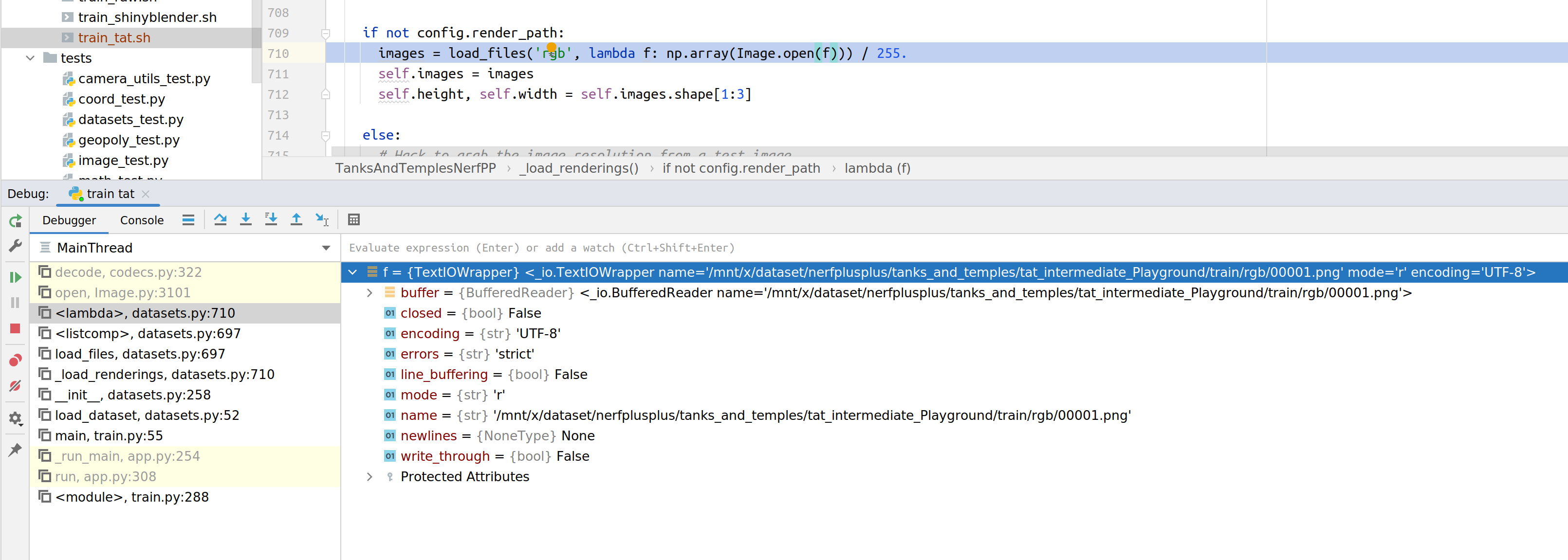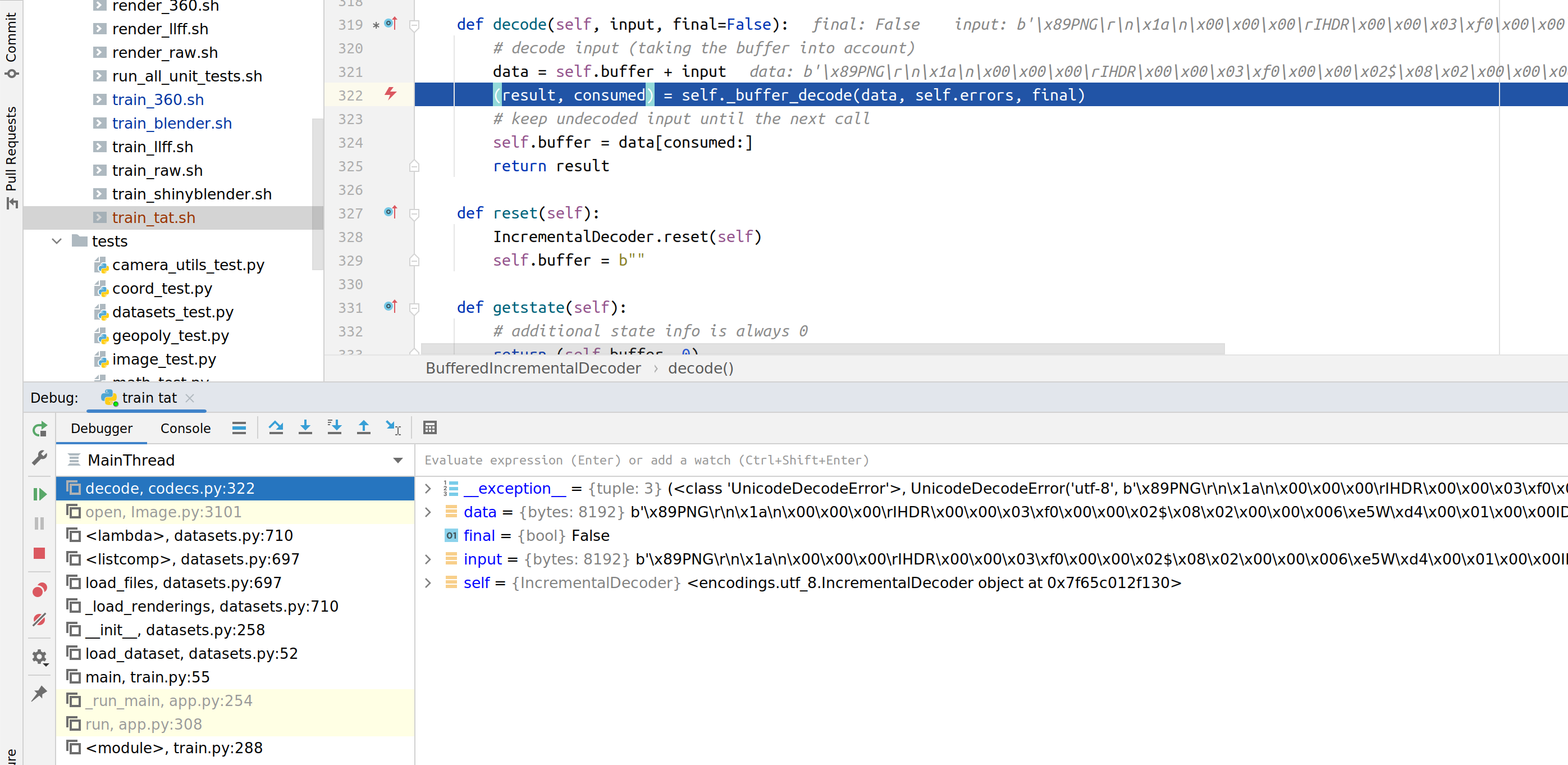This is not an officially supported Google product.
This repository contains the code release for three CVPR 2022 papers: Mip-NeRF 360, Ref-NeRF, and RawNeRF. This codebase was written by integrating our internal implementations of Ref-NeRF and RawNeRF into our mip-NeRF 360 implementation. As such, this codebase should exactly reproduce the results shown in mip-NeRF 360, but may differ slightly when reproducing Ref-NeRF or RawNeRF results.
This implementation is written in JAX, and is a fork of mip-NeRF. This is research code, and should be treated accordingly.
# Clone the repo.
git clone https://github.com/google-research/multinerf.git
cd multinerf
# Make a conda environment.
conda create --name multinerf python=3.9
conda activate multinerf
# Prepare pip.
conda install pip
pip install --upgrade pip
# Install requirements.
pip install -r requirements.txt
# Manually install rmbrualla's `pycolmap` (don't use pip's! It's different).
git clone https://github.com/rmbrualla/pycolmap.git ./internal/pycolmap
# Confirm that all the unit tests pass.
./scripts/run_all_unit_tests.sh
You'll probably also need to update your JAX installation to support GPUs or TPUs.
Example scripts for training, evaluating, and rendering can be found in
scripts/. You'll need to change the paths to point to wherever the datasets
are located. Gin configuration files
for our model and some ablations can be found in configs/.
After evaluating on the test set of each scene in one of the datasets, you can
use scripts/generate_tables.ipynb to produce error metrics across all scenes
in the same format as was used in tables in the paper.
You may need to reduce the batch size (Config.batch_size) to avoid out of memory
errors. If you do this, but want to preserve quality, be sure to increase the number
of training iterations and decrease the learning rate by whatever scale factor you
decrease batch size by.
Summary: first, calculate poses. Second, train MultiNeRF. Third, render a result video from the trained NeRF model.
- Calculating poses (using COLMAP):
DATA_DIR=my_dataset_dir
bash scripts/local_colmap_and_resize.sh ${DATA_DIR}
- Training MultiNeRF:
python -m train \
--gin_configs=configs/360.gin \
--gin_bindings="Config.data_dir = '${DATA_DIR}'" \
--gin_bindings="Config.checkpoint_dir = '${DATA_DIR}/checkpoints'" \
--logtostderr
- Rendering MultiNeRF:
python -m render \
--gin_configs=configs/360.gin \
--gin_bindings="Config.data_dir = '${DATA_DIR}'" \
--gin_bindings="Config.checkpoint_dir = '${DATA_DIR}/checkpoints'" \
--gin_bindings="Config.render_dir = '${DATA_DIR}/render'" \
--gin_bindings="Config.render_path = True" \
--gin_bindings="Config.render_path_frames = 480" \
--gin_bindings="Config.render_video_fps = 60" \
--logtostderr
Your output video should now exist in the directory my_dataset_dir/render/.
See below for more detailed instructions on either using COLMAP to calculate poses or writing your own dataset loader (if you already have pose data from another source, like SLAM or RealityCapture).
In order to run MultiNeRF on your own captured images of a scene, you must first run COLMAP to calculate camera poses. You can do this using our provided script scripts/local_colmap_and_resize.sh. Just make a directory my_dataset_dir/ and copy your input images into a folder my_dataset_dir/images/, then run:
bash scripts/local_colmap_and_resize.sh my_dataset_dir
This will run COLMAP and create 2x, 4x, and 8x downsampled versions of your images. These lower resolution images can be used in NeRF by setting, e.g., the Config.factor = 4 gin flag.
By default, local_colmap_and_resize.sh uses the OPENCV camera model, which is a perspective pinhole camera with k1, k2 radial and t1, t2 tangential distortion coefficients. To switch to another COLMAP camera model, for example OPENCV_FISHEYE, you can run
bash scripts/local_colmap_and_resize.sh my_dataset_dir OPENCV_FISHEYE
If you have a very large capture of more than around 500 images, we recommend switching from the exhaustive matcher to the vocabulary tree matcher in COLMAP (see the script for a commented-out example).
Our script is simply a thin wrapper for COLMAP--if you have run COLMAP yourself, all you need to do to load your scene in NeRF is ensure it has the following format:
my_dataset_dir/images/ <--- all input images
my_dataset_dir/sparse/0/ <--- COLMAP sparse reconstruction files (cameras, images, points)
If you already have poses for your own data, you may prefer to write your own custom dataloader.
MultiNeRF includes a variety of dataloaders, all of which inherit from the base Dataset class.
The job of this class is to load all image and pose information from disk, then create batches of ray and color data for training or rendering a NeRF model.
Any inherited subclass is responsible for loading images and camera poses from
disk by implementing the _load_renderings method (which is marked as
abstract by the decorator @abc.abstractmethod). This data is then used to
generate train and test batches of ray + color data for feeding through the NeRF
model. The ray parameters are calculated in _make_ray_batch.
To work from an example, you can see how this function is overloaded for the different dataloaders we have already implemented:
- Blender
- DTU dataset
- Tanks and Temples, as processed by the NeRF++ paper
- Tanks and Temples, as processed by the Free View Synthesis paper
The main data loader we rely on is LLFF (named for historical reasons), which is the loader for a dataset that has been posed by COLMAP.
To make a new dataset, make a class inheriting from Dataset and overload the
_load_renderings method:
class MyNewDataset(Dataset):
def _load_renderings(self, config):
...
In this function, you must set the following public attributes:
- images
- camtoworlds
- pixtocams
- height, width
Many of our dataset loaders also set other useful attributes, but these are the
critical ones for generating rays. You can see how they are used (along with a batch of pixel coordinates) to create rays in camera_utils.pixels_to_rays.
Images
images = [N, height, width, 3] numpy array of RGB images. Currently we
require all images to have the same resolution.
Extrinsic camera poses
camtoworlds = [N, 3, 4] numpy array of extrinsic pose matrices.
camtoworlds[i] should be in camera-to-world format, such that we can run
pose = camtoworlds[i]
x_world = pose[:3, :3] @ x_camera + pose[:3, 3:4]
to convert a 3D camera space point x_camera into a world space point x_world.
These matrices must be stored in the OpenGL coordinate system convention for camera rotation: x-axis to the right, y-axis upward, and z-axis backward along the camera's focal axis.
The most common conventions are
[right, up, backwards]: OpenGL, NeRF, most graphics code.[right, down, forwards]: OpenCV, COLMAP, most computer vision code.
Fortunately switching from OpenCV/COLMAP to NeRF is
simple:
you just need to right-multiply the OpenCV pose matrices by np.diag([1, -1, -1, 1]),
which will flip the sign of the y-axis (from down to up) and z-axis (from
forwards to backwards):
camtoworlds_opengl = camtoworlds_opencv @ np.diag([1, -1, -1, 1])
You may also want to scale your camera pose translations such that they all
lie within the [-1, 1]^3 cube for best performance with the default mipnerf360
config files.
We provide a useful helper function camera_utils.transform_poses_pca that computes a translation/rotation/scaling transform for the input poses that aligns the world space x-y plane with the ground (based on PCA) and scales the scene so that all input pose positions lie within [-1, 1]^3. (This function is applied by default when loading mip-NeRF 360 scenes with the LLFF data loader.) For a scene where this transformation has been applied, camera_utils.generate_ellipse_path can be used to generate a nice elliptical camera path for rendering videos.
Intrinsic camera poses
pixtocams= [N, 3, 4] numpy array of inverse intrinsic matrices, OR [3, 4]
numpy array of a single shared inverse intrinsic matrix. These should be in
OpenCV format, e.g.
camtopix = np.array([
[focal, 0, width/2],
[ 0, focal, height/2],
[ 0, 0, 1],
])
pixtocam = np.linalg.inv(camtopix)
Given a focal length and image size (and assuming a centered principal point,
this matrix can be created using
camera_utils.get_pixtocam.
Alternatively, it can be created by using
camera_utils.intrinsic_matrix
and inverting the resulting matrix.
Resolution
height = int, height of images.
width = int, width of images.
Distortion parameters (optional)
distortion_params = dict, camera lens distortion model parameters. This
dictionary must map from strings -> floats, and the allowed keys are ['k1', 'k2', 'k3', 'k4', 'p1', 'p2'] (up to four radial coefficients and up to two
tangential coefficients). By default, this is set to the empty dictionary {},
in which case undistortion is not run.
The public interface mimics the behavior of a standard machine learning pipeline
dataset provider that can provide infinite batches of data to the
training/testing pipelines without exposing any details of how the batches are
loaded/created or how this is parallelized. Therefore, the initializer runs all
setup, including data loading from disk using _load_renderings, and begins
the thread using its parent start() method. After the initializer returns, the
caller can request batches of data straight away.
The internal self._queue is initialized as queue.Queue(3), so the infinite
loop in run() will block on the call self._queue.put(self._next_fn()) once
there are 3 elements. The main thread training job runs in a loop that pops 1
element at a time off the front of the queue. The Dataset thread's run() loop
will populate the queue with 3 elements, then wait until a batch has been
removed and push one more onto the end.
This repeats indefinitely until the main thread's training loop completes (typically hundreds of thousands of iterations), then the main thread will exit and the Dataset thread will automatically be killed since it is a daemon.
If you use this software package, please cite whichever constituent paper(s) you build upon, or feel free to cite this entire codebase as:
@misc{multinerf2022,
title={{MultiNeRF}: {A} {Code} {Release} for {Mip-NeRF} 360, {Ref-NeRF}, and {RawNeRF}},
author={Ben Mildenhall and Dor Verbin and Pratul P. Srinivasan and Peter Hedman and Ricardo Martin-Brualla and Jonathan T. Barron},
year={2022},
url={https://github.com/google-research/multinerf},
}
























